Occitania
Occitania
Occitània | |
|---|---|
Nation | |
 | |
|
Flag | |
| Etymology: Oc (yes in Occitan) + "itania" from Aquitania | |
| Anthem: Se Canta (Occitan) "If it sings" | |
 Linguistic map of Occitania (ca. 1900) | |
| Coordinates: 44°18′00″N 2°52′41″E / 44.3000°N 2.8781°E | |
| Continent | Europe |
| Area | |
| • Total | 198,113 km2 (76,492 sq mi) |
| Population | |
| • Total | 16.1 million |
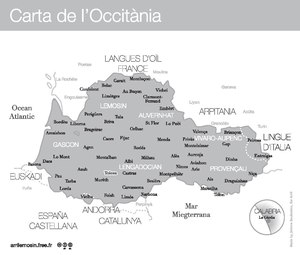
Occitania (
).Occitania has been recognized as a linguistic and cultural concept since the
Currently, the region has a population of 16 million, and between 200,000–800,000
Under Roman Empire rule, most of Occitania was known as
).The historic
On 28 September 2016, Occitanie became the name of an administrative region that succeeded the regions of Midi-Pyrénées and Languedoc-Roussillon;[13] it is a small part of Occitania.
Geographic extent


The extent of Occitania may vary according to the criteria used:
- Based on a geolinguistic definition, Occitania is the area of Occitan language as surveyed at the end of the 19th century.[14][15] The formerly Occitanophone regions are not included.[16]
On the other hand one always speaks Occitan in the
- Occitanian culture flourished in the High Middle Ages. Many writers, poets, and exponents in the troubadour movement used Occitan as their language of choice, and their works prominently featured courtly love as well as, at times, ideas of religious and social tolerance.[20] According to this definition taken up by historians and anthropologists,[21] the domain is extended north to the Loire including former Occitanophone regions[22] (Aguiaine, Boischaut, Bourbonnais, etc.).
Northern Italy and the Catalan Countries were also homes of troubadour using the Koiné Occitan literary. In the same way, the Basque Country and Aragon benefited from Occitan stands, old or newer, which notably gave rise to the appearance of an Occitan dialect south of the Pyrenees. We can also note the historical use of an Occitan scripta as official language.[23][24][25]
The name Occitanie appeared in the Middle Ages on the basis of a geographical, linguistic and cultural concept, to designate the part of the French royal domain speaking the langue d’oc.[26]
Its current definition is variable. In the most common usage, Occitania designates the territory where the Occitan has remained used until today,[27][28][29] within the limits defined between 1876[30] and the 20th century.[31] If Occitan language and culture are almost always associated with it,[27][28][29][32] we also find references to a common history,[32][33] an ethnic group,[32][33] a homeland,[34][35] to a people[36][37][38][39][40] or to a nation.[41][42][43][44] The first sociological study in Occitan language to know how the Occitan define themselves was started in 1976.[45] The survey shows that the Occitan reality is defined by language for 95% of people, culture (94%), characterization by a common history (69%), an ethnic group (50%), a nation (20%).[32] Occitania, as defined by the modern Occitan linguistic territory, covers most of the current Southern France, the Alpine valleys of the Western Piedmont, in Italy, Val d'Aran in Spain and Monaco[46][47] an area of approximately 190,000 km2. It had about fifteen million inhabitants in 1999[48] with about 20% inhabitants born outside the territory[49] and about 20% of the natives who left.[50] On the other hand, in the absence of a linguistic census, we know only imperfectly the number of speakers of Occitan.[51]
If the preceding notions are generally limited to the modern linguistic boundaries of Occitan, this term can also be used to designate a larger territory. The term "Occitania" becomes commonplace more and more in the vocabulary of scientists.
In 2016, the name Occitanie is used for the French administrative region
Toponymies
Occitania comes from the medieval Latin Occitania. The first part of the name, Occ-, comes from Occitan òc and the expression langue d'oc, in Italian lingua d'oc. It is an appellation promoted by Dante Alighieri of Occitan by the way of saying "yes" in Old Occitan-Catalan; as opposed to the "langue de si" (Italian) and the "langue d'oïl" (Old French). The ending -itania is probably an imitation of the name [Aqu] itania (Aquitaine). The term Occitania is a synonym for Languedoc and the Mediterranean coast in the Middle Ages.[54]
The first attestation of the use of Occitanie in French dates from 1556.[55][56][57] The first certificate of Occitania in Italy dates 1549.[58] In German, the word Occitania was found in 1572.[59]
All of the Occitan language countries have had various designations throughout history. The word Occitania has been the subject of whimsical etymologies (for example,
-
Testament of Lancelot of Orgemont, 1286. The installation of a real Parliament in Toulouse in 1273 chaired by a certain Lancelot d'Orgemont is disputed.[62] The original of the document presented here could date from the 15th century.
-
Entry oucitanìo in The Treasure of Felibritge of Frederic Mistral
-
Pars occitana in a book printed in Latin in 1530.
Like the Occitan language, Occitania has been designated under various successive names.[63] The terms are not exclusive: one can find authors who use different terms in the same time period. Occitania or Pays d'Oc are the most frequently used terms today. However the term Provence is still used when the Felibritge sing the Copa Santa for example during the annual festival of Estello.
- Dioecesis Viennensis (Diocese de Vienne) et Dioecesis Septem Provinciarum (diocesis of the Seven provinces), under Diocletian and Constantine during a division of the Roman Empire, Gaul is divided into dioceses and that of Vienne has its border on the Loire river, bypasses the Central Massif and passes the Rhône between Lyon and Vienne.[64] This is the beginning of the bipartition between Occitan language and langue d'oil.
- Marca Hispanica, Septimania and Provence.
- Proensa/Proença (old Occitan forms of Provence) and Prouvènço/Provença (Occitan modern forms of Provence), from the Latin Provincia which originally designated the Roman Province is used from the 11th century: all countries of Occitan language (also called Provençal language) of the south of the Loire. The term Provence is still used in its general sense by the Felibritgists.
- Great Provence according to Palestra, Centenary of the Catalan Renaixença.[65]
- Patria romana.[66]
- Lingua Occitana (Occitan language) or Pars occitana (Part of oc) to designate the new royal territories conquered south of the Loire. Occitania was created in Latin by the Capetian administration with the combination of the particle 'Oc/òc' [ɔk] (yes, in Occitan) and of the 'Aquitania/Aquitània' [ɑkitanjɑ] (Aquitaine). Appeared in the 13th century,[67] this term served, after the annexation of almost all the countries of the South by France, to designate only the Languedoc.
- Respublica Occitania (Occitania Republic) during the 14th century.[68]
- Romania (Roumanío), in reference to the medieval usage of calling Occitan the roman.[69]
- Homeland of the Occitan language (Latin patria linguae occitanae), in the official texts of the Kingdom of France from the 14th century.
- Provinces of the Union or United Provinces of the South: in February 1573 the huguenots and the moderate Catholics create a federal republic where each province enjoys a great autonomy vis-a-vis the central power.[70]
- Gascony after the Ordinance of Villers-Cotterêts, "the general name of Gascony or Gascons is used to refer to the countries and peoples to the left side of the Loire where still speaks the old Provençal".[71] Used mainly from the access to the throne of France of Henri IV (1589) and until the French Revolution.[72]
- Reputed foreign provinces of the south of France since the middle of the 17th century at the end of the 18th century
- Occitania in the Diderot Encyclopaedia.[73]
- Occitanie (in the sense of all the Occitan languages): in 1732 in the collection of Capetian laws of Shake Secousse,[74] in 1878, in the Treasure of the Felibritge, in 1911 in the Statutes of the Felibritge;[75] in 1927, Estieu and Salvat founded the College of Occitania.[76]
- Midi: is a vague geographical notion indicating in a rather imprecise way the regions of Occitan dialects of Southern France.
- Southern France: is another vague geographical name indicating in a rather imprecise way the regions of Occitan dialects of Southern France.
- Pays d'Oc: appeared in the 19th century under the impetus of Frederic Mistral,[77] taken over by Antonin Perbòsc four years later.
- Estate of Oc: neologism appeared at the end of the 20th century among supporters of several Occitan languages.
The term "Occitania" now covers a linguistic region. This meaning was used in medieval times attested since 1290.
Historiography of the Occitania concept
The langue d'oc is a territorialized language, that is to say, spoken mainly on a territory whose boundaries can be described. This part attempts to describe the origins of the Occitanie concept, the different names that this territory has taken and the creation of the modern concept of Occitania.
A unique object of study: d'oc culture
The speakers of the Occitan language do not use a single meaning of their language because Occitan is not a monolithic language with for example a single dictionary where each speaker finds exactly their vocabulary, but a juxtaposition of dialects. Also, many studies have focused on the differences between Provençal, Languedoc, etc. We must also remember the many common features of the Occitan cultural space, which are generally considered partisans.
The consciousness of a common culture
Robert Lafont develops this idea in the introduction of the "History and Anthology of Occitan Literature".[80] The reference to troubadours is essential. This socio-linguistic argument is modulated according to the authors but it is accepted by all the current scholarship, including the authors who speak of "domain d'oc", since by definition, their study of the d'oc domain rests on the consciousness of the existence of a common culture.
Intercomprehension
The different speakers of the language share many common traits (tonic accentuation, close vocabulary, frequent use of the subjunctive, etc.) that allow mutual understanding. For Occitanists, this intercomprehension means that Occitan is one language; for others, it means that these languages are very close but all agree that the speakers in this defined space understand each other.
Common social characteristics
The social characteristics of Occitania are not eternal and intangible because factors of endogenous mutations[81] and European influences, especially of Northern France, can blur these social peculiarities.[82]
The best studied example is that of
With regard to education: Pierre Goubert and Daniel Roche write, to explain the low literacy in Occitania in the 18th century, that there exists in these territories a confidence maintained in the old vulgar languages.[84] The relations to education are today completely reversed between Northern and Southern France thanks to the anthropological imprint of the family strain.[85][86]
From a demographic point of view, the influence of the family was still felt in 2007 because of the small number of families with many children.[87]
In politics, many debates have also taken place around the expression Red Southern coined by Maurice Agulhon[88] to find out if the "pays d'oc" was more "republic" than the northern half of France. Emmanuel Todd analyzing the regions that voted for Jean-Luc Mélenchon, calling himself a "Republican" in the 2012 presidential elections, declares that "what is obvious is his general inscription in the Occitan family[...] that loves vertical structures, the state or the church."[89]
Finally, for André Armengaud,[90] these common social characteristics make it possible to write a historical synthesis. But since 1979, no other "History of Occitan" has been undertaken.
The appearance of the modern concept of Occitania
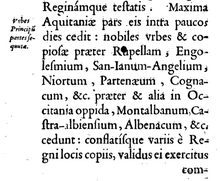
If the term Occitania appeared in

It appeared in the Treasury of Felibritge and in the statutes of this organization in 1911.[97] In the Interwar period, a Felibritgan school, the Escòla Occitana was created in 1919 in the Toulousean Languedoc. The Institute of Occitan Studies was born in 1930. These initiatives (as well as others) remain closely linked, notably because of the dual membership of their main animators at Felibritge.
After the
In France, Occitania has been confronted with a problem of recognition of Occitan since 1992; the French is the only "language of the Republic". In 1994, it was made compulsory in the public space (places of commerce and work, public transport, etc.) and in the administration (laws, regulations, documents, judgments, etc.).[99]
In 2015, with the prospect of creating a large region gathering "
Distinction between Occitania and Catalonia
Despite the historic and political dependencies between the 10th and 13th centuries that eventually led to the creation of a common Occitan-Catalan cultural environment during Middle Ages,
Regarding to linguistic affinity and closeness, after some early Romance-language scholars considered them to be the same language,[106] Catalan intellectuals (among them Pompeu Fabra and Joan Coromines) solemnly proclaimed in a 1934 manifesto that Catalan was a distinct language from Occitan,[107] as established by the common consensus of current scientific linguistics.[108]
Moreover, the
Geography


Occitania includes the following regions:
- The southern half of . French is now the dominant language in this area, where Occitan is not recognized as an official language.
- The Occitan Valleys in the Italian Аlps, where the Occitan language received legal status in 1999. These are fourteen Piedmontese valleys in the provinces of Cuneo and Turin, as well as in scattered mountain communities of the Liguria region (province of Imperia), and, unexpectedly, in one community (Guardia Piemontese) in the region of Calabria (province of Cosenza).
- The where Occitan has been an official language since 1990 (status granted by the partial autonomy of Aran Valley, then confirmed by the Catalan Statute)
- The Principality of Monaco (where Occitan is traditionally spoken beside Monégasque).
Catalan is a language very similar to Occitan and there are quite strong historical and cultural links between Occitania and Catalonia.
Historic regions
The regions of
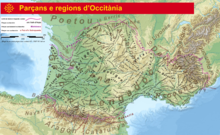
Traditional Occitan Provinces (currently in France):
- Béarn [Bearn] (Pau) – 6,800 km2 (est.)
- Guyenne [Guiana] & Gascony (Bordeaux) – 69,400 km2 (est.)
- Limousin [Lemosin] (Limoges) – 9,700 km2 (est.)
- La Marche (Limousin) [la Marcha] (Guéret) – 7,600 km2 (est.)
- Auvergne [Auvèrnhe] (Riom) – 19,300 km2 (est.)
- Languedoc [Lengadòc] (Toulouse) – 45,300 km2 (est.)
- Dauphiné (Grenoble) – 8,500 km2 (est.)
- County of Nice [County of Nissa] (Nice) – 3,600 km2 (est.)
- Provence [Provença] (Aix-en-Provence) – 22,700 km2 (est.)
- Comtat Venaissin [lo Comtat Venaicin] (Carpentras) – 3,600 km2 (est.)
- County of Foix [County of Fois] (Foix) – 3,300 km2 (est.)
X. Bourbonnais (southern half) – approx. 3,200 km2 (est.)
Administrative divisions in France
The administrative regions covering Occitania are the following:
Geographical boundaries
The geographical delimitation of Occitania most commonly accepted was specified between 1876—beginning of research on the linguistic boundaries[110]—and the 20th century. Occitania roughly covers a southern third of France (commonly known as Midi, including Monaco), the Occitan Valleys and Guardia Piemontese, in Italy, as well as the Val d'Aran, in Spain.
The practice of Occitan is not the same uniformly throughout the territory. In addition, there is a linguistic transition area in the north called
- Several zones were dissocialized more or less precociously such as the Franco-Provençal languagein the Rhône-Alpes, the lower valleys of the Alps competed with the Piedmontese and Ligurian (Italy).
- The area "charnègue" ("métis" in Gascon) is influenced by the Basque Country because several Gascon communes were part of the former province essentially Basque Labourd and are now located in the west of the Pyrénées-Atlantiques department: Bidache, Guiche, Came, Urt, Bassussarry, Montory, Mouguerre.[112] It is a region where both Basque and Occitan Gascon cultures coexist for a long time, just like the families of mixed marriages.[113]
- In several regions of the world we meet historical speakers of Occitan. These areas are not considered Occitan, with the exception of Guardia Piemontese which is a linguistic enclave in southern Italy.
- The zone of the Ligurian phonetic, lexical and morphologic traits (Werner Forner,[116] Jean-Philippe Dalbera[117] and Giulia Petracco Sicardi[118] The Brigasc is a variant of the Royasc with addition of Occitan traits.[119]
History
This article's tone or style may not reflect the encyclopedic tone used on Wikipedia. (May 2012) |
Written texts in Occitan appeared in the 10th century: it was first used in legal texts, and then in literary, scientific, and religious texts. Spoken

Occitania was often politically united during the Early Middle Ages, under the
Occitan literature flourished during this time period: in the 12th and 13th centuries, the troubadours invented courtly love (fin'amor), and the Lenga d'Òc spread throughout European cultivated circles; the terms Lenga d'Òc, Occitan, and Occitania first appeared at the end of the 13th century.
From the 13th to the 17th centuries, the
In 1789, the revolutionary committees tried to re-establish the autonomy of the "Midi" regions, using the Occitan language; however, Jacobin power prevented its realization.
The 19th century witnessed a strong revival of the Occitan literature, exemplified by the writer
-
The Diocese of Vienne, 300 AC.
-
TheKingdom of Aquitaine, 806
-
Languedoc in 1209
-
Expulsion of the inhabitants from Carcassone in 1209
-
Protestant regions in modern France at the 16th century
Outer settlements
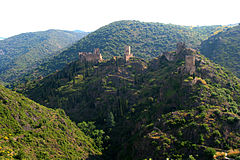
Although not really a colony in a modern sense, there was an Occitan
Around the 14th century, some "Provençal" settlements were founded by Valdenses in S southern Italy: the Capitanata?[clarification needed] area, Basilicata, and Calabria. Most of them were destroyed by the Inquisition during the 16th century, but the Guardia Piemontese[clarification needed] managed to keep its language and Occitan identity until now.
At the end of the 17th century, Valdenses fleeing persecution in the Occitan valleys settled in
In the 19th century, Occitans settled in the Americas. Some Valdense colonies have retained their use of the language down to the present day, such as those in Uruguay and the United States.
Cultural and political movements
Occitanist associations or organizations
The oldest Occitanist association is the
The main movements in France are as follows:
- Felibritge historical Mistralian, literary and linguistic movement.
- Institut d'Estudis Occitans (IEO), maintenance and development of the Occitan language and culture as a whole.
- Calandreta, private associations of Occitan schools of private status
- Several associations or organizations are grouped around the Felibritge, the IEO and the Calendretas.
- Conselh de la Lenga Occitana (CLO), scientific organization of codification of Occitan in the classical norm.
- Federacion dels Ensenhaires de Lenga e Cultura d'Òc (FELCO), set of teachers and parents of students related to the teaching of Occitan in the public sector.
- Parlaren mistral movement in Provence.
- Academy of arts, letters and sciences of Languedoc
- Marpoc Law 1901 association: Occitan course, Occitan summer university, an Occitan café, colloquiums, conferences, shows and concerts, painting and publishing exhibitions of the "Mar e Mont" collection.
- Òc-Bi, an association of parents of schoolchildren for public bilingual education.
- Centre de Formacion Professionala d'Occitània-Miègjorn-Pirenèus, a professional organization dedicated to the transmission of the Occitan language and culture to adults.
- Collègi d'Occitania founded in 1927, teaching the Occitan language and culture.
- Centre Interregional de Desvolopament de l'Occitan, collaborative digital media library around Occitan culture and language.
- COMDT - Occitan Center for Traditional Music and Dance: a resource center for Occitan culture of oral tradition, transmission and dissemination of traditional music and dance.
- Collectiu Dètz, audiovisual professionals around the Occitan language and culture.
- CORDAE/La Talvera, Occitan center for research, documentation and ethnographic animation.
- Institut Occitan Aquitània, Regional Operator for the Occitan language and culture.
In Italy, the main movements are:
- Associazione Culturale Occitano - Guardiola
- Coumboscuro Cèntre Prouvençal
- Espaci Occitan, an association of public administration of the Occitan alpine territory whose objective is the linguistic, cultural and tourist promotion of the Italian Occitan valleys.
- The Valaddo
- Movimento Autonomista Occitano
- Ousitanìo Vivo
- Soulestrelh
- Valados Usitanos
- Renaissença Occitana, cultural association that publishes the history and local language magazine La Rafanhaudaa.
In Spain:
- Institut d'Estudis Araneses-Acadèmia Aranesa de la Lenga Occitana (IEA)
- Oficina de Foment e Ensenhament der Aranés
- Conselh Generau d'Aran
- Museum of the Val d'Aran
- Aran General Archive
Anti-Occitanist Associations
Some associations adhering to Felibritge and Parlaren claim a Provençal language distinct from Occitan.
Other associations claim distinct "languages d'oc", even if, paradoxically, some of them are grouped together in an Alliance of Oc languages:
- Association advocating a distinct Auvergne identity: Cercle Terre d'Auvergne.
- Association advocating a distinct Béarnaise and Gascon language: Institut Béarnais et Gascon.
- Association advocating a distinct Cevenol language: Lou Clu en Ceveno.
- Associations advocating a distinct Provençal language: the Unioun Prouvençalo and its equivalent for Italy Unioun Prouvençalo Transaupino, the Collectif Prouvènço and its Italian equivalent Consulta provenzale.
Some associations have no affiliation with other oc countries:
- Association advocating a distinct Niçoise language: Acadèmia Nissarda.
- Associations advocating a distinct Provençal language: the Astrado Prouvençalo.
Pan-Occitanist associations
On the other hand, some groups claim an Occitan-Roman identity including the Catalan Countries (France-Spain).
- Groups actively participating in Eurocongress 2000: Occitan-Catalan Federation, Occitan-Catalan Fundation, Occitan-Catalan Circle of Twinning, Euroccat Association, Espaci Occitan Association.
- Other groups: Oc Valéncia Centre Internacional de Recerca i Documentació Científica.
Politics
Spain
In Spain, Aranese political parties alternately run the
In the 2017 Catalan regional election, the electors of the Val d'Aran voted mostly for "constitutionalists," parties which support continued union with Spain.[124]
France
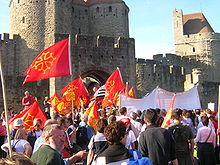
In France, Occitan political parties and movements (such as the
- Gardarem la Tèrra: altermondialist.
- Iniciativa Per Occitània, political, cultural and social laboratory: independentist movement.
- Freedom ! esquèrra revolucionària occitana is a pan-occitan far-left movement that replaced "Anaram on Patac", "Combat d'Òc" and "Hartèra" at the refounding convention of 19 September 2009.
- League for the restoration of Nicean freedoms: contests the annexation of the county of Nice to the French State in 1860.
- Nissa Rebela: Nicean autonomist party, close to the identity bloc.
- Linha Imaginòt: altermondialist.
- Languedocian Regionalist Movement: electoral coalition close to the PNO.
- Occitània Libertària: anarcho-communist.
- Our Country (País Nòstre): regionalist, established in Languedoc. Occitanie País Nòstre throughout Occitania since November 2019.
- Party of the Occitan Nation (PNO): moderate independence.
- Occitan Party (PÒC): autonomist, left/center-left. The PÒC adheres to larger entities:
- Since 2009, he has been inscribed in France in the Europe Écologie list as a participant in Regions and Peoples with Solidarity(RPS).
- European Free Alliance/Democratic Party of the Peoples of Europe (FTA/PDPE): The PÒC is a member of this European party.
- Greens–European Free Alliance (Greens/EFA group): Political group of the European Parliament.
- Since 2009, he has been inscribed in France in the
- Unitat d'Òc: federates political activists from different horizons (PNO, PÒC and independent)
- Bastir!: social movement claiming attachment to Occitania (culture, history, environment ...)
| Political parties | Ideology |
|---|---|
| Occitan Party | Regionalism |
| Party of the Occitan Nation | Occitan nationalism |
| Freedom ! | Occitan nationalism |
Italy
- Paratge: laboratory of political ideas. Its main section is in the Occitan Valleys (Italy). Its Provençal section is called Para(t)age Mar, Ròse e Monts.
- Movimento Autonomista Occitano (MAO): branch of the Party of the Occitan Nation in the Italian Occitan Piedmont. Only their newspaper Ousitanio Vivo continues to appear.
Monaco
There are currently no Occitan political movements in Monaco.
Former movements
Former political movements include:
- Anaram Au Patac: far left, participated in the CRÒC
- Occitan Comitat d'Estudis e d'Accion (COEA): Leftist autonomist. It was created in 1965.[131]
- Comitats d'Accion Occitana (CAO): Left.
- Corrent Revolucionari Occitan (CRÒC): separatist linked to the far left revolutionary.
- Entau País: leftist autonomist established in Gascony.
- Farem tot petar
- Communist Anarchist Federation of Occitan (FACO): independentist, libertarian communist.
- Hartèra, movement of the revolutionary youth of Occitania: extreme left.
- Lucha Occitana: group of intellectuals, students and agricultural unionists, ideologically left revolutionary, autonomist and socialist.
- Movement Socialista e Autonomista Occitan.
- Partit Provençau: autonomist.
- Pòble d'Òc: independentist and libertarian.
- The movement Volèm Viure al País (VVAP): socialist movement composed of different self-managing local groups. It no longer exists but the slogan that it has in fact taken up is often used. It was dissolved in 1987 to make room for the Occitan Party.[132]
Today

This section may need to be rewritten to comply with Wikipedia's quality standards. (October 2010) |
There are 14 to 16 million inhabitants in Occitania today. According to the 1999 census, there are 610,000 native speakers and another million people with some exposure to the language. Native speakers of Occitan are to be found mostly in the older generations. The Institut d'Estudis Occitans (IEO) has been modernizing the Occitan language since 1945, and the Conselh de la Lenga Occitana (CLO) since 1996. Nowadays Occitan is used in the most modern musical and literary styles such as rock 'n roll, folk rock (Lou Dalfin), rap (Fabulous Trobadors), reggae (Massilia Sound System) and heavy metal, detective stories or science-fiction. It is represented on the internet. Association schools (Calandretas) teach children in Occitan.
The Occitan political movement for self-government has existed since the beginning of the 20th century and particularly since post-war years (
Major demonstrations in Carcassonne (2005 and 2009) and Béziers (2007) and the week-long Estivada festivals in Rodez (2006–2010) suggest that there is a revival of Occitan language and culture. However, in France, Occitan is still not recognized as an official language, as the status of French has been constitutionally protected since 1992, and Occitan activists want the French government to adopt Occitan as the second official language for seven regions representing the South of France. [citation needed]
Language
The Occitan language is only recognized as official, protected and promoted in the Val d'Aran (in Spain); in Italy it has the status of a protected language; and in France it only has acceptance in the educational network but without legal recognition.
The Fédération des langues régionales pour l'enseignement public calculated the number of students in the Occitan language in October 2005 at 4,326.[133]
According to a 2002 report by the French Ministry of Culture (Report to Parliament on the use of the French language, 2003), in public schools, collèges and lycées and private schools: in the academic year 2001–02, 67,549 students had enrolled in classes of or in Occitan.
Despite this precarious social position, Occitan was one of the official languages of the 2006 Turin Winter Olympics.
Culture
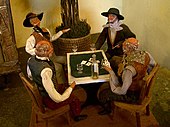
Literature
- The troubadour school first marked the emergence of a distinct Occitan culture during the High Middle Ages. The troubadours were highly appreciated for their refined lyricism and influenced many other similar "schools" throughout Europe. Troubadourism (the later shorthand) remained a tradition for centuries and its members were mainly from the aristocracy; the movement was epitomized by William IX, Duke of Aquitaine and Bertran de Born.
- Occitan literature experienced a rebirth during the Baroque period, mainly in Gascony through the Béarnese dialect. Indeed, Béarnese was the mother-tongue Henry IV of France, whose designation sparked a relative enthusiasm for Béarnese literature with the publication of works by Pey de Garros and Arnaud de Salette. Toulouse was also an important place for this renaissença, especially through the poems of Pèire Godolin. Nonetheless, Occitan literature following the death of Henry IV went into a significant period of decline, as witnessed by the fact that local poets, such as Clément Marot, began to write in French.
- Nobel Prize in literature, illustrating the curiosity about the Provençal dialect (which was considered an exotic language) in France and in Europe at that time, with his Irish friend and colleague, the poet William Bonaparte-Wyse, choosing Provençal as his own language of composition.
- L'Acadèmia dels Jòcs Florals(The Academy of the Floral Games), held every year in Toulouse, is considered one of the oldest literary institution in the Western world (founded in 1323). Its main purpose is to promote Occitan poetry.
- In 1945 the cultural association L'Institut d'Estudis Occitans (The Institute of Occitan Studies) was created by a group of Occitan and French writers, including Jean Cassou, Tristan Tzara and Renat Nelli. Its purpose is to maintain and develop the language and influence of Occitania, mainly through the promotion of local literature and poetry.
Music
Romantic composer Gabriel Fauré was born in Pamiers, Ariège in the Pyrenees region of France. Déodat de Séverac, another Romantic music composer, was also born in the region, and, following his schooling in Paris, he returned to Occitania to compose; he sought to incorporate the music indigenous to the area into his compositions.
Cuisine

Occitan cuisine is considered Mediterranean, but has some specific features that separate it from Catalan cuisine or Italian cuisine. Indeed, because of the size of Occitania and the great diversity of landscapes- from the mountaineering of the Pyrenees and the Alps, rivers and lakes, and finally the Mediterranean and Atlantic coast – it can be considered as a highly varied cuisine. Compared to other Mediterranean cuisines, Occitan gastronomy significantly uses basic elements and flavors, such as meat, fish and vegetables, along with the frequent usage of olive oil; elements from Atlantic coast cuisine are also common, such as cheeses, pastes, creams, butters and other high-calorie foods. Well-renowned meals common on the Mediterranean coast include ratatolha (the equivalent of Catalan samfaina), alhòli, bolhabaissa (similar to Italian Brodetto alla Vastese), pan golçat (bread with olive oil), and salads with mainly olives, rice, corn and wine. Another significant aspect that distinguishes Occitan cuisine from that of its Mediterranean neighbors is the abundant amount of aromatic herbs; some of them are typically Mediterranean, like parsley, rosemary, thyme, oregano or again basil.
Some world-renowned traditional meals are Provençal
Occitania is also home of a great variety of cheeses (like
Image gallery
-
Saint-Sernin's Basilica's chevet, Toulouse. The largest Romanesque church in Europe.
-
Global view of the village of Conques.
-
View of the episcopal city of Albi.
-
View of the Old Town of the colorful city of Menton, on the French Riviera.
-
View ofMarseilles, the largest city in Occitania.
-
The Cistercian abbey ofSénanque.
-
Palais des Papes of Avignon.
-
Gorges du VerdonCanyon.
-
One of the many lakes of the Mercantour National Park, in the French Alps.
-
The fortified town of Carcassonne, Aude.
-
The Roman Pont du Gard.
-
The headquarters of Michelin, Clermont-Ferrand.
-
A traditionalCognac distillery, Charente.
-
A surfer at Soorts-Hossegor, considered as one of the best surfing spots in the world.[134]
-
festival period.
-
University of Montpellier's Faculty of Medicine, the oldest and still-active medical school in the world[135]
See also
- Arpitania
- Association internationale d'études occitanes
- Baìo
- List of Occitans
- Occitan conjugation
- Occitan cross
- Occitan cuisine
- Occitan nationalism
- Occitania national football team
- Occitano-Romance languages
- Southern France
Notes
References
- ^ "The ancient language of the South France, was called, la langue d'oc, from the sound of its affirmative particle. From this circumstance, the country has been called Occitanie, and a specific portion of it, Languedoc. The French have lately formed a new adjective, Occitanique, to comprize all the dialects derived from the ancient tongue." in Sharon Turner, The history of England (during the middle ages), London, Longman, Hurst, &c. 1814. Read on GoogleBooks
- ^ Map of the Roman Empire, ca400 AD
- ^ Map of the Visigothic Kingdom
- '^ Map of the 806 divisio regnorum'. Louis' share in yellow.
- ^ Fabrice BERNISSAN (2012). "Combien l'occitan compte de locuteurs en 2012 ?", Revue de Linguistique Romane, 76 (12/2011-07/2012), pp. 467-512
- ^ « De fait, le nombre des locuteurs de l’occitan a pu être estimé par l’INED dans un premier temps à 526 000 personnes, puis à 789 000, » ("In fact, the number of occitan speakers was estimated by the French Demographics Institute at 526,000 people, then 789,000") Philippe Martel, "Qui parle occitan ?" in Langues et cité Archived 2012-03-16 at the Wayback Machine n°10, December 2007.
- ^ "World Directory of Minorities and Indigenous People". Archived from the original on 2009-04-29.
- ^ Jean-Pierre Juge (2001) Petit précis – Chronologie occitane – Histoire & civilisation, p. 14.
- ^ Joseph Anglade, Grammaire de l'ancien provençal ou ancienne langue d'oc, 1921, Part I, Chapter 1, p. 9: Le mot Langue d'Oc a d'abord désigné le pays où se parlait cette langue; c'était une expression géographique. Le pays de langue d'oc s'appelait en Latin Occitania (formé sans doute sur Aquitania) ("The words Langue d'Oc first designated the country where the language was spoken: it was a geographical expression. The land of the langue d'oc was called Occitania in Latin (probably coined from Aquitania").
- ^ Frederic Mistral, Lo Tresor dóu Felibrige (1878–1886), vol. II, p. 1171: "Les textes abondent qui montrent l'origine française ou ecclésiastique des expressions lingua occitana et Occitania. Le pape Innocent IV (1242–1254), un des premiers parle de Occitania dans ses lettres; les commissaires de Philippe le Bel qui rédigèrent l'arrêt sanè des coûtumes de Toulouse se déclarent Ad partes linguae occitanae pro reformatione patriae designati et stipulent que leur règlement est valable in tota lingua occitaniae."
- ^ Robèrt LAFONT (1986) "La nominacion indirècta dels païses", Revue des langues romanes nº2, tome XC, pp. 161–171.
- ^ Bodo MÜLLER. "Langue d'Oc, Languedoc, Occitan", in: Verba et Vocabula, Festschrift Ernst Gamillscheg, München 1968, pp. 323-342.
- ^ "Décret n° 2016-1264 du 28 septembre 2016 portant fixation du nom et du chef-lieu de la région Occitanie - Legifrance". www.legifrance.gouv.fr. Archived from the original on 2017-04-14. Retrieved 2017-04-13.
- ^
Robert Lafont, Clefs pour l'Occitanie, Seghers, 1971; p. 11Occitanie means all the regions where we speak dialect of the Romance language called "langue d'oc". Occitania will therefore be defined on the map by the linguistic boundaries.
- ^
Occitania is everywhere where one has, in France, "the accent of the South", to the except for the department of Pyrénées-Orientales, which is Catalan, Corsica and the Basque Country. The Occitanophones are distributed in about thirty departments located south of a line that goes from the estuary of the Gironde to the Alps. It passes northern Libourne, eastern Angouleme, northern Confolens (Charente), Bellac (Haute-Vienne), northern Limoges, between Gueret and Aubusson (Creuse), between Vichy (Allier) and Riom (Puy-de-Dome). In the Saint-Etienne basin, Firminy is grazed on the south by the line that reaches the great Alps by cutting the Dauphiné in two. Grenoble is bordering on Occitania, which begins in La Mure. Finally, from La Mure to Besançon, and from Saint-Étienne to Friborg in Switzerland, there is an intermediate zone between Oc and Oïl; the Franco-Provençal area. Thus, Occitan is spoken in ten historical provinces: Guyenne, Gascony, County Foix, Béarn, Limousin, Auvergne, Languedoc, Provence, Dauphiné (south) and Nice. We must add the Val d'Aran, in the Spanish Pyrenees, and the Vaud valleys of Piedmont, in the Italian Alps.
— Jean-Pierre Richardot (1929-), Les Bacheliers de Montsêgur, "The World of Education," September 1976 - ^
Robert Lafont, "Clefs pour l'Occitanie", Seghers, 1971; p. 13It may be thought that 12th century, Occitania was still biting on Saintonge and Poitou. A process of northernization has allowed to read Occitan in transparency of the dialects of this region.
- ^ Occitan on the Basque television Archived 2016-03-04 at the Wayback Machine Jornalet December 2, 2014
- ^ Okzitanierak bizi duen egoeraz Archived 2016-03-05 at the Wayback Machine EITB 23 November 2014
- ^ Las enclavas lingüisticas Archived 2016-09-15 at the Wayback Machine, language = oc| Sumien Domergue| text = Sumien Domergue, Jornalet, 29 August 2016
- ISBN 1470961687
- ^ a b We can quote in particular the demographer Hervé Le Bras and the historian Emmanuel Todd who often use it in several of their works.
- ^ ISBN 9782070758425, 768 pages
- , November 2009
- ^ An Occitan scripta in the Kingdom of Navarre in the Middle Ages (13th–16th centuries) (formation and functioning) Archived 2016-03-04 at the Wayback Machine Louis Grange, 2012
- ^ Occitan medieval scripta in Euskal Herria (full text) Archived 2015-09-21 at the Wayback Machine Ricardo Cierbide Martinena Fontes linguae vasconum: Studia et documenta, ISSN 0046-435X, Año n° 25, 62, 1993, pp. 43-60
- ^ "Le pouvoir royal et la lingua de hoc, alias Occitania" Archived 2015-04-12 at the Wayback Machine : "It is the irruption of the Capetian power far south of its original domain which causes the manufacture of the name of the countries which it integrates henceforth with this field. We can not call them "County of Toulouse", or "Viscount of Albi, Béziers, Carcassonne", since there are more viscounts since the late Montfort, nor counts after the death of Alphonse in 1271. However, we must find a clear designation, which is done at the end of 13th century. This will be the part of the royal domain where we speak a language that is not that of the other party, there in the north: the Langue d'oc, in latin Occitania. This can include, at random conquests, other areas where the same language is spoken ..."
- ^ ISBN 2-232-11190-3.
- ^ ISBN 2-01-006039-3
- ^ ISBN 2-912966-73-6
- ^ Début des recherches sur les frontières linguistiques avec notamment Charles de Tourtoulon and Octavien Bringuier, Study on the geographical limit of the langue d'oc and langue d'oïl (with a map), 1876, Paris: Imprimerie nationale [reed. 2004, Masseret-Meuzac: Institute of Occitan Studies of Lemosin/Lo Chamin de Sent Jaume].
- Francoprovençal.
- ^ a b c d Yvon Bourdet. Maria Clara Viguier Occitans sense o saber (Occitan without knowing it), Language and society, 1980, vol. 11, number 1, pp. 90-93. Maria Clara Viguier Occitans sense o saber (Occitans without knowing it)
- ^ a b Universalis Encyclopedia – Occitan Language and Literature Archived 2017-07-29 at the Wayback Machine "Language of an Ethnicity Who Was Not A Nation, Its history is the constant quest for awareness that the most diverse imperatives have constantly challenged.
- ^ Jean Jaurès in: Jean Jaurès cahiers trimestriels, Issues 151-154, Society of Jaurésiennes Studies, publisher Society of Jaurésiennes Studies, 2000
- ^ Simone Weil and the Occitan homeland. Jews and Jewish Source in Occitania, Blanc Jòrdi, Vent Terral, Enèrgas, 1988, pp. 123-137.
- ^ Mistral and the Occitan people, Sylvain Toulze, Society of Occitan Publishers, 1931
- ^ "The Occitan people want to take the street for their rights – La Dépêche du Midi". Archived from the original on 2017-07-22. Retrieved 2017-12-28.
- ^ "Occitan people – Douarnenez Film Festival". Archived from the original on 2013-12-15. Retrieved 2017-12-28.
- ^ PNO Manifesto, French version Archived 2013-12-15 at the Wayback Machine
- ^ Eurominority.eu, Association for the Promotion of Minorized European Peoples – Occitanie
- ^
. 'Cartabeu de Santo-Estello' Archived 2016-03-03 at the Wayback Machine, n° 14, Avignon: 1924–1925.Lou Felibrige es establi pèr garda longo-mai à la nacioun óucitano sa lengo, sis us, soun gàubi e tout ço que coustituïs soun eime naciounau. (The Felibrige is established to preserve the language, the traditions, the characters and all that constitutes the national spirit of the Occitan Nation.)
— Coll. Estatut dóu Felibritge (Bylaws of the Félibrige adopted in 1911) - ^
François Fontan (excerpts from: The Occitan Nation, Its Frontiers, Its Regions, 1969) Archived 2011-01-09 at the Wayback Machine.All the characteristics of a nation, other than the language, are found in Occitania and we can see here also how much the language is the synthetic index of the nation. The Occitan originality is well marked compared to the neighboring ethnic groups, and this in all points of view: racial (racial compound where blood O is more frequent than in France, than in Italy or in Catalonia, less predominant in Euskadi), origin of the population (Ligures, Iberians and Gauls, strong Latin contingent, weak Visigoth input); ethnopsychological; political (Aquitaine uprisings under the Carolingians, National State of the Counts of Toulouse, union of all "the people of our language" against the French invasion, then constant peasant uprisings in all provinces, independent states during the wars of religion: Marseille, Montauban and especially Béarn, Cévennes' War, Girondins autonomism, finally since the 19th century, constant opposition vote giving majorities called "left" or ensuring the success of what appeared momentarily as the more protesting (Poujadism, Mitterrand), cultural (from the civilization of the troubadours, called by Engels a pre-Renaissance to Mistral and our contemporary literature), finally (and some will say above all) demographic, economic and social: underdevelopment and relative regression with neighboring ethnic groups (Italy, Catalonia, Euskadi and especially France), formerly known as escape of capital and now non-use or plunder of our resources by France, numerical predominance of the class of small-owners.
— The Occitan nation, its borders, its regions - ^ See the Occitan Nation Party.
- ^ Text of law for the recognition of the Occitan national reality of Val d'Aran in Catalonia, Spain: Val d'Aran wants more autonomy
- ^ Occitans sens o saber ?; Maria Clara Viguièr; Vent Terral, 1979, Documents, Paperback 190 p -Sociological Essay-
- ^ There is also a variant of Occitan Monegasque aboriginal (district of the Port à la Condamine and Saint Roman) -called patois- which is called Moneguier. (René ANFOSSO, speaker of Moneguier p. 51 in REVEST Laurenç Nissa e Occitània per Garibaldi. Garibaldian anthology of Oc, publisher Serre, Nice, 212 p.).
- ^ "15% of the population of Monaco speaks Niçard variety of Provençal, which strongly French influences from the Monegasque territory. In fact, people speaking Niçard are mainly people over 50, but Provencal increases its status as a literary language (translated from: "A further 15% of the population of Monaco speaks the Niçard variety of Provençal, which greatly influences the French of the Monegasque region. In fact, the Niçard speaking community is comprisedof over 50 years of age, Provençal is increasingly gaining status as a literary language}} "Monaco: "Language Situation", in Encyclopedia of Language & Linguistics (Second Edition)}}, 2006, p. 230 [1] Archived 2012-05-12 at the Wayback Machine.
- ^ On the basis of the French census of 1999, the population was estimated at 14 million inhabitants, see: ALCOUFFE Alan (2001) Cultura occitana e devolopament economic, 361-382 [13 of December 2000], Treballs de la Societat catalana de geografia, vol. XVI, 2001, num. 52 Societat catalana de geografia 1 Archived 2010-07-01 at the Wayback Machine and Societat Catalana de Geografia 2 Archived 2010-10-02 at the Wayback Machine
- ^ "About 20% of the current population is born outside the territory (from 30 to 35% in Provence, less than 20% in the western territory). This immigration occurred mainly between 1975 and 1993. The languages spoken by the newcomers are mainly French and then the languages of immigration (Arabic, Berber, etc.). In The Euromosaic-Occitan study in France.
- ^ "About 20% of the population born in the territory left for work elsewhere, especially between 1963 and 1975. The most important causes are: the lack of employment opportunities, the industrial crisis and the mechanization of the work of the agricultural sector. European Commission> Languages> Euromosaic – Occitan in France
- ^ Philippe Martel admits: "let's say we do not know how many Occitanophones there are in this country" Martel Philippe, "Who speaks Occitan?","Languages and city", 10, Paris, DGLFLF, 12/2007.
- ISBN 2222047153
- ISBN 2226222782
- ^ J. Stefanini, The meaning of the term "Occitanique" at Fabre d'Olivetds International Congress. of lang. and litt. of Southern France, Aix-en-Provence, 1961, p. 209
- ^ "It fires me in Narbonne, Aiguesmortess, Nymes & Besiers, colony & nille of great name, inhabited by IADIS soldiers the seventh legion of Rome, including the country man may seem auoir prins his name, then Easting Appointee Septimanie, and to present Ocitane & Languedo instead that the nõmoit Gotthicane, depending on whether we have dictated deuant." Two links of Paul Aemyle of the history of France, traduicts of Latin in French, by Simon de Monthiers, In Paris, From the printing press of Michel de Vascosan, leaving in the Rue S.Iaques, with the sign of the fountain. MD LVI (1556) p. 92. Read online Archived 2017-12-28 at the Wayback Machine
- ^ See also, later, "Arade, genti-homme de ceste Prouince Occitanie...", in Les récits historiques ou histoires divertissantes, entremeslées de plusieurs agreables rencontres & belles reparties. Par Iean-Pierre Camus, Evesque de Belley. In Paris, at Gervais Clousier, at the Palace, on the steps of the Saincte Chapelle. MDCXLIV en linha Archived 2014-09-03 at the Wayback Machine.
- ISBN 979-1-09-069605-1.
- ^ Egli tutto pien d'ira Carlo attacò il fuoco, e spianò Narbona, Agate, Nemauso, e Biterra nobile Colonia de' Settumani, onde pare che hauesse tutta quella contrada il nome, che alhora si chiamava Settimania, & hora (come s'è gia detto) in uece di Gotticana, è chiamata Ocitania." Historia delle cose di Francia, raccolte fedelmente da Paolo Emilio da Verona, e recata hora a punto dalla Latina in questa nostra lingua Volgare, Venezia: Michele Tramezzino; 1549. online (images 144-145) and also. Archived 2016-02-28 at the Wayback Machine
- ^ Frantzösischer und anderer Nationen mit einlauffender Historien warhaffte Beschreibung: biß auff Henricum den Anderen ... in Neunthehen Bücher verfasset ... Sampt aller Königen Bildtnussen, Volum 2 Archived 2017-12-28 at the Wayback Machine p. 740.
- ^ Gilles Ménage, Dictionnaire étymologique de la langue française, 1750.
- ^ "This province was long known as "Gallia Narbonensis", then Septimania. When the Roman Empire was divided again, the name of Occitania was given to the regions westward (of Provence), and of Novempopulania to the province of Bordeaux."
- ^ "RIGAUDIÈRE, Albert. Chapitre III. La royauté, le Parlement et le droit écrit aux alentours des années 1300 In : Penser et construire l’État dans la France du Moyen Âge (XIIIe-XVe siècle), 2003. "
- ^ Revista tolsana Infòc, number 265, Genièr 2008.
- ^ Pierre Bec, op. cit., p. 20.
- ^ http://myriamchabrun.chez.com/felibrige/carte12e.gif [bare URL image file]
- ISBN 9 782866 175399
- ^ Louis-Étienne Arcère, Histoire de la Ville de la Rochelle et du Pays d'Aulnis, 1756, p. 40 online.
- ^ Pierre Bec, op. cit., p. 65.
- ^ "Roumanio • Tresor dóu Felibrige - Dictionnaire provençal-français". Archived from the original on 2016-08-17. Retrieved 2017-12-29.
{{cite web}}: CS1 maint: bot: original URL status unknown (link) - ^ The United Provinces of the South Archived 2015-08-12 at the Wayback Machine, note published on the Musée virtuel du protestantisme
- ^ Dom Vaissette.
- ^ Alain Viaut quotes the Languedocian dictionary of the Abbé de Sauvages (1785): Hence it follows that not only the Provençal, but all Gascon idioms of the southern provinces are within the purview of our dictionary. Alain Viaut, "Practices and representations of Occitan in Aquitaine", in Variable territoriale et promotion des langues minoritaires, MSHA, 2007, p. 146 online.
- ^ "OCCITANIA (Geog. Anc.) Is the name that some authors of the Middle Ages gave to the province of Languedoc but this name was common to all the people who said yes, that is to say, to the inhabitants of Gascony, Provence, Dauphine, and Languedoc, whose modern name was formed.".
- ^ Explanation Online.
- ^ a b Article Óucitanìo (in Mistralian norm, for Occitània in classical norm) in: Frédéric Mistral (1879 - 1886) Lou Tresor dóu Felibrige, Provençal-French Dictionary, Aix-en-Provence: Remondet-Aubin [reed. 1979, Aix-en-Provence: Edisud, 2 vols.] [Available online at http://gallica.bnf.fr/ark:/12148/bpt6k7486f Archived 2017-09-18 at the Wayback Machine]. See also the statutes of Felibritge adopted in 1911, article 11: Tóuti li Felibre majourau o manteneire soun coumparti dins de seicioun terrenalo dicho mantenènço e courrespoundènto, tant que se pòu, is anciano prouvinço de l'Óucitanìo o i grand dialèite de La Lengo d'O "All major felibritgists or maintainers are divided into territorial sections known as maintenances and corresponding, as far as possible, to the former provinces of Occitania or the great dialects of the Occitan language."
- ^ Pierre Pasquini, Le pays des parlers perdus, preface by Robert Lafont, Montpellier, Presses du Languedoc, 1994, see page 160 for more clarification.
- ^ Frédéric Mistral, Oucitanìo article, The Treasure of the Felibritge, 1878.
- ^ Robèrt Lafont (1986) Indirect nominacion dels païses, Revue des langues romaines number 2, volume XC, pp. 161-171.
- ^ André Dupuy, Marcel Carrieres and André Nouvel, Histoire de l'Occitanie, Publisher Connaissance de l'Occitanie, Montpellier, 1976 p. 58.
- ^ Robert Lafont, "The Classical Age", Volume I of the "History and Anthology of the Occitan literature", Montpellier, Presses du Languedoc, 1997.
- ^ See The Invention of Europe of Emmanuel Todd.
- ^ see chapters 2, 3 and 5 of this book Archived 2011-11-05 at the Wayback Machine. Jean-François Gerkens, Ibid, pp. 74-75.
- ^ Private Law Compared By Jean-François Gerkens .
- ^ Goubert and Roche Archived 2007-06-09 at the Wayback Machine.
- ^ "Démographie : en trente ans, comme vous avez changé !". Archived from the original on 2016-03-03. Retrieved 2017-12-30.
- ^ "The level of education in Europe in 2010". Archived from the original on 2017-12-31. Retrieved 2017-12-30.
- ^ "INSEE-Part des familles nombreuses". Archived from the original on 2015-09-24. Retrieved 2018-11-03.
- ^ is the red midi really a reality? Interview with Jean-Jacques Becker and Gilles Candar, published in the journal Arkheia number 17-18.
- ISBN 978-2-02-127909-2, p. 176, map p. 177
- ^ Andre Armengaud and Robert Lafont (dir.), "Histoire d'Occitanie", Paris, Hachette, 1979, 949 pages.
- ^
in Jean-Pierre Camus, Les Récits historiques ou histoires divertissantes, entremeslées de plusieurs agreables rencontres & belles reparties Archived 2014-09-03 at the Wayback Machine, 1644.Arade, genti-homme de ceste Prouince Occitanie
- ^
in Jean Besly, History of the Counts of Poitou and the dukes of Guyenne since 811 to Louis the Younger Archived 2017-12-31 at the Wayback Machine, 1647.Raimond I count of Tholose or if Occitanie
- ^ Orders of the Kings of France of the third race... Third volume, Containing the ordinances of King John from the beginning of the year 1355 until his death arrived April 8, 1364 / by M. Secousse, Imprimerie Royale, Paris, 1732, on line on Gallica Archived 2017-12-31 at the Wayback Machine.
- ^ Mullié, Charles (1852). . (in French). Paris: Poignavant et Compagnie.
General Frégeville had to fight the occult orders of the duke Angouleme and his chief of staff, the Duke of Damascus. The Prince's plan was to disorganize the army; he succeeded, and General Frégeville was retired. It is known that the Duke of Angouleme was suspected at that time of wanting to form an independent kingdom under the name of the Kingdom of Occitania.
- ^ "Faced with these excesses, fear outweighs explicit convictions -as evidenced by the isolation of Voyer d'Argenson when he denounces them in the House- and the central government is struggling to react: the prefects appointed by the government only arrive in his departments at the end of July, and suffer from the competition of the commissioners who have been appointed by the Duke of Angouleme. The latter is also recalled to Paris by Louis XVIII, who cancels all the nominations to which his nephew had proceeded and published, on September 1st, a "proclamation on the excesses of the South". Written by Pasquier, this text condemns the "odious enterprise" described as "an attack against us and against France". The royal intervention puts an end to the troubles -except in Nîmes, where they continue until November- strongly reminding that no one can substitute for the authority of the king. But it aroused the anger of the leaders of exalted southern royalism (the Marquis of Villeneuve, the Abbé de Chièze, the Baron of Calvière) who, having failed to establish a Viceroyalty of Occitania, had hoped to take advantage circumstances to restore the institutions of the Ancien Régime to the benefit of the local nobility. Bertand GOUJON. Post-Revolutionary Monarchies. 1814-1848. Paris: The Threshold. 2012.
- ^ History of England During the Middle Ages, 1814.
- ^ "The Felibritge is established to preserve the language, the customs, the genius of the Occitan nation. Its doctrine is contained in the works of Frédéric Mistral and his disciples") Article 2 of the statutes in the Cartabèu de Santo Estello online at CIEL d'Oc[permanent dead link]
- ^ Simon Calamel and Dominique Javel, The Langue d'oc for standard, p. 203: "IEO ... competitive organization but not necessarily enemy... created in 1945".
- ^ Law n°94-665 of August 4, 1994 relative to the use of the French language Archived 2011-10-27 at the Wayback Machine "Any inscription or announcement affixed or made on the public road, in a place open to the public or in a means of public transport and intended for the information of the public must be formulated in French."
- ^ "What is the Occitanie region?". Archived from the original on 2018-01-02. Retrieved 2018-01-02.
- ^ Survey for the new name of the large region regrouping "Midi-Pyrénées" and "Languedoc-Roussillon" [2]
- ^ S2CID 235076124. Retrieved 20 April 2023.
- ISBN 9788439361497.
- OCLC 36407762.
- ISSN 2013-3995.
- ^ Lamuela, Xavier. "Catalan and Occitan: one diasystem, two languages". www.trob-eu.net. TrobEu, Trobadours and European Identity. Retrieved 20 April 2023.
- Universitat Pompeu Fabra. pp. 679–682.
- ^ "Catalan language". www.britannica.com. Encyclopaedia Britannica. Retrieved 20 April 2023.
Catalan is most closely related to the Occitan language of southern France and to Spanish, but it is clearly distinct from both.
- ^ "Catalonia recognizes Aran's national identity". Nationalia. CIEMEN. 2015-01-21. Retrieved 20 April 2023.
- ^ Notably Carles de Tortolon, & Octavien Bringuier, Étude sur la limite géographique de la langue d’oc et de la langue d’oïl (avec une carte), 1876, Paris: Imprimerie Nationale [reed. 2004, Masseret-Meuzac: Institute of Occitan Estudis of Lemosin/Lo Chamin of Sent Jaume].
- ^ See for example the map in Occitània i l'occità Archived 2012-04-13 at the Wayback Machine, a popular work on Occitania and Occitan published by the Autonomous Government of Catalonia (in Catalan).
- ^ Guiche, Came, Urt, Bidache, Bassussarry, Montory, Mouguerre... are they really Gascon?.
- ^ Sharnègos Archived 2012-01-24 at the Wayback Machine.
- ^ "In fact, the community of Brigue has its most distant origins in the emigrations of the 12th century after the conquest of Languedoc and Provence by the "barons of the North", conquest followed by religious persecutions (note 10). Thus, their language is a Provençal speech with an old Ligurian substratum in which words from French were mixed.
(Note 10) Traces of Provençal civilization can be found in some Alpine valleys of Piedmont [...] In Liguria we can find smaller traces in Lower Roya (Olivetta San Michele, Airole, Libri) and in the Alps. Rochetta Nervina, Pigna and Triora. Guido Lucarno, "The peace treaty of 1947 between Italy and France. Consequences on the Border and on the Development of the Roya Valley", p. 121 in André-Louis Sanguin, Mare Nostrum : dynamiques et mutations géopolitiques de la Méditerranée, Paris : L'Harmattan, 2000. - ^ Werner Forner, "Smoke and fire. About attempts to delimit the Occitan south-east area. First part: From 1850 to 1950", in P. Fabre (ed.), Mixes dedicated to the memory of Prof. Paul Roux, La Farlède (Var Association for the Teaching of Provençal), 1995, pp. 155–180.
- ^ Werner Forner, "About the ligurian intemelian. The coast, the hinterland", in Works of the Linguistic Circle of Nice, 7-8 (1985–1986), Werner Forner, Areallinguistik I: Ligurian, in Lexikon der Romanistischen Linguistik (LRL), IV, Tübingen 1988, pp. 453-469.; Werner Forner, «Linguistic Geography and Reconstruction, in the example of the Ligurian Intemelian», in Proceedings of the I International Symposium on Ancient Provençal, Ancient French and the Ancient Ligurian, Nice, September 1986 ("Bulletin of the Center for Romanticism and Late Latinity"), Nice 1989, pp. 125-140., Werner Forner, «Fra Costa Azurra e Riviera: be li ngue in contatto", in V. Orioles, Fiorenzo Toso (ed.), Circolazioni linguistiche e culturali nello spazio mediterraneo. Miscellanea di studi, Recco 2008, pp. 65-90.
- ^ Jean-Philippe Dalbera, Les parlers des Alpes-Maritimes. Étude comparative. Essai de reconstruction.. London 1994, publication of the International Association of Occitan Studies.
- ^ Giulia Petracco Sicardi, E. Azaretti, "Studi linguistici sull'anfizona Liguria-Provenza", In Dizionario Etimologico Storico Ligure, Alessandria 1989, at pp. 11-62., di Giulia Petracco Sicardi,"Contribute alla definizione dell'anfizona Liguria-Provenza".
- ^ "The Brigasc has an Occitan component that denies the belief of some people that this speech would be part of the Ligurian dialects." The feeling of belonging to the Occitan culture is sufficiently shared by the locals "on the A Vaštéra site[permanent dead link].
- ^ Jean-Pierre JUGE (2001) Petit précis – Chronologie occitane – Histoire & civilisation, p. 19.
- Frederic Mistral, Lou Tresor dóu Felibrige ou Dictionnaire provençal-français embrassant les divers dialectes de la langue d'oc moderne (1878–1886), vol. I, p. 1182: "Le poète Racine écrivait d'Uzès en 1662: «Nous appelons ici «la France» tout le pays qui est au-delà de la Loire. Celui-ci passe comme une province étrangère.»"
- ^ Joseph Anglade, Grammaire de l'ancien provençal ou ancienne langue d'oc, 1921: La Langue d'Oc est parlée actuellement par douze ou quatorze millions de Français ("Occitan is now spoken by twelve or fourteen million French citizens").
- ^ Ferriòl Macip (2015), "Val d'Aran: the end of bipartidism?", La Setmana/Jornalet (in Occitan), archived from the original on 2018-01-04, retrieved 2018-01-03
- ^ "ELECCIONES CATALANAS 2017- ARAN", El País (newspaper) (in Spanish), 2017, archived from the original on 2018-01-04, retrieved 2018-01-03
- ^ Results of the 2010 regional elections in Aquitaine Archived 2010-06-23 at the Wayback Machine and Departmental section: PYRENEES ATLANTIQUES (64) Archived 2011-04-02 at the Wayback Machine
- ^ L’Occitanie présente au Conseil régional Archived 2015-04-02 at the Wayback Machine.
- ^ "Les élu-e-s, fonctions et bios > Hervé GUERRERA". Archived from the original on 2016-04-01. Retrieved 2018-01-03.
- ^ "Results of the second round" (in French). 2014. Archived from the original on 2018-03-15. Retrieved 2018-01-03.
- ^ "Lista dels elegits municipals" (PDF) (in Occitan). 2014. Archived (PDF) from the original on 2016-03-03. Retrieved 2018-01-03.
- ^ "Les députés Le Groupe des Verts/Alliance Libre Européenne" (in French). Archived from the original on 2015-03-26.
- ^ Chemins d'occitanie-Camins d'occitania: Politique Occitane 1974-2000, Gérard Tautil, Éditions L'Harmattan, 1998, p. 20.
- ^ Chemins d'occitanie-Camins d'occitania: Occitan Politics 1974-2000, Gérard Tautil, Éditions L'Harmattan, 1998, p. 17.
- ^ "Les langues régionales enseignées". Archived from the original on 2013-03-18. Retrieved 2018-01-03.
- ^ Alexander, Harriet (2 November 2009). "Surfing: 10 best places in the world". Archived from the original on 2017-12-28. Retrieved 2018-04-04 – via www.telegraph.co.uk.
- ^ "Montpellier, France: The Oldest Medical School in Europe". MD Magazine. Archived from the original on 2016-03-05. Retrieved 2015-05-02.
- ^ "History of the Club | Pau GOLF CLUB 1856". www.paugolfclub.com. Archived from the original on 24 September 2015. Retrieved 15 January 2022.

![Testament of Lancelot of Orgemont, 1286. The installation of a real Parliament in Toulouse in 1273 chaired by a certain Lancelot d'Orgemont is disputed.[62] The original of the document presented here could date from the 15th century.](http://upload.wikimedia.org/wikipedia/commons/thumb/b/b2/Langue_de_Oc_%281286%29.png/120px-Langue_de_Oc_%281286%29.png)





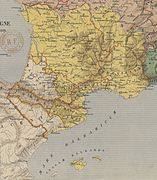

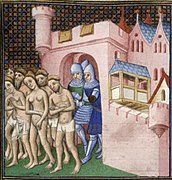









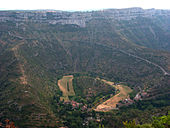




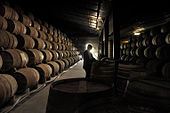
![A surfer at Soorts-Hossegor, considered as one of the best surfing spots in the world.[134]](http://upload.wikimedia.org/wikipedia/commons/thumb/a/ab/Hossegor_2008_%283%29.jpg/170px-Hossegor_2008_%283%29.jpg)

![University of Montpellier's Faculty of Medicine, the oldest and still-active medical school in the world[135]](http://upload.wikimedia.org/wikipedia/commons/thumb/d/df/Montpellier_Faculte_medecine.jpg/170px-Montpellier_Faculte_medecine.jpg)
![Pau Golf Club, the oldest golf club in Continental Europe.[136]](http://upload.wikimedia.org/wikipedia/commons/thumb/5/55/Pau_Golf_Club_3.jpg/170px-Pau_Golf_Club_3.jpg)